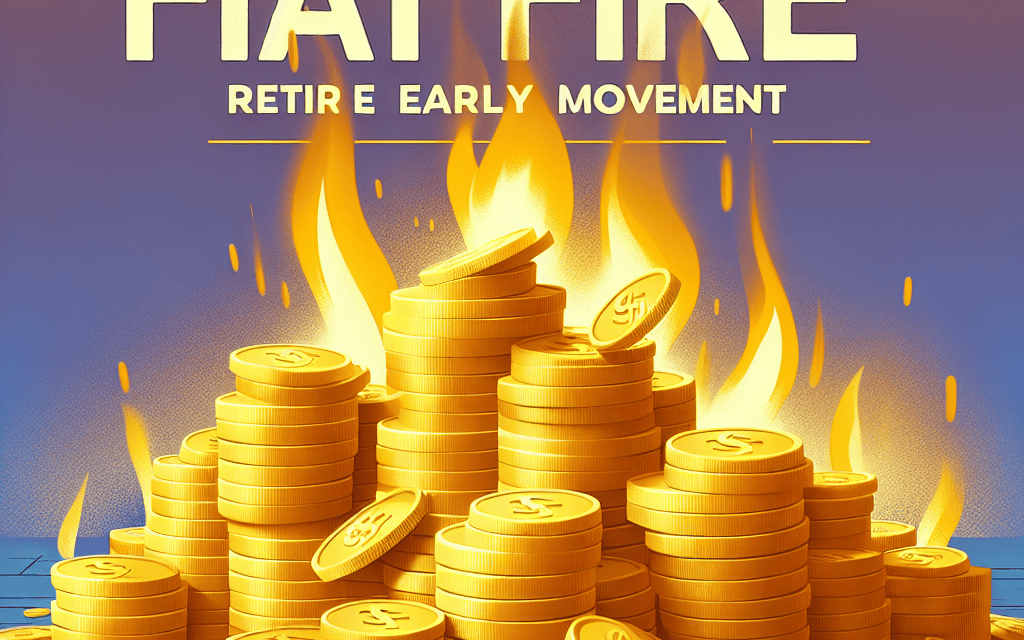“Unlock the Secret to Luxurious Early Retirement: FAT FIRE’s $4 Million Blueprint!”
Introduction
The FAT FIRE movement, a subset of the broader Financial Independence, Retire Early (FIRE) community, advocates for a retirement strategy that emphasizes financial abundance and a comfortable lifestyle. Unlike the traditional FIRE approach, which often focuses on frugality and minimalism, FAT FIRE encourages accumulating a more substantial nest egg to support a higher standard of living in retirement. Recent discussions within the movement suggest that aspiring FAT FIRE adherents should aim for a retirement fund exceeding $4 million. This figure is designed to provide not only financial security but also the freedom to enjoy life’s luxuries without the constraints of a tight budget. By targeting this ambitious savings goal, individuals can ensure a retirement that is both financially secure and richly fulfilling, allowing for travel, leisure, and the pursuit of personal passions without financial worry.
Understanding the FAT FIRE Movement: A Path to Luxurious Early Retirement
The concept of early retirement has long captivated the imaginations of those seeking financial independence and a life unburdened by the constraints of traditional employment. Among the various strategies that have emerged to achieve this goal, the FAT FIRE movement stands out for its emphasis on not just retiring early, but doing so with a level of financial security that allows for a luxurious lifestyle. Unlike the more frugal approaches of other financial independence movements, FAT FIRE advocates for accumulating a substantial nest egg, often recommending a target of over $4 million. This figure, while daunting to some, is rooted in the desire to maintain a high standard of living without the need to compromise on comfort or indulgence.
To understand the rationale behind this ambitious target, it is essential to consider the underlying principles of the FAT FIRE movement. At its core, FAT FIRE is about achieving financial independence with a cushion that allows for discretionary spending, travel, and the pursuit of passions without financial constraints. This approach contrasts with the leaner FIRE strategies, which focus on minimizing expenses and living a more austere lifestyle. By aiming for a larger financial reserve, FAT FIRE adherents seek to eliminate the stress and uncertainty that can accompany a more modest retirement fund.
The recommended $4 million target is not arbitrary; it is based on careful calculations that take into account various factors such as inflation, healthcare costs, and potential market fluctuations. By setting a high bar, the movement encourages individuals to plan meticulously and invest wisely, ensuring that their retirement funds can withstand economic downturns and unexpected expenses. This level of preparedness is particularly appealing to those who wish to enjoy their retirement years without the constant worry of outliving their savings.
Moreover, the FAT FIRE movement recognizes that retirement is not a one-size-fits-all proposition. The lifestyle one envisions in retirement can vary significantly from person to person, and the movement encourages individuals to tailor their financial goals to their personal aspirations. For some, this may mean maintaining a residence in an expensive city, while for others, it could involve frequent international travel or the pursuit of costly hobbies. By setting a high financial target, FAT FIRE provides the flexibility to accommodate these diverse desires.
Transitioning from a traditional career to early retirement requires not only financial preparation but also a shift in mindset. The FAT FIRE movement emphasizes the importance of cultivating a lifestyle that aligns with one’s values and passions, rather than being dictated by financial necessity. This holistic approach to retirement planning encourages individuals to think deeply about what they truly want from their post-career years and to take proactive steps to achieve those dreams.
In conclusion, the FAT FIRE movement offers a compelling vision of early retirement that prioritizes financial abundance and personal fulfillment. By advocating for a retirement fund of over $4 million, it challenges individuals to think beyond mere financial survival and to aspire to a life of comfort and freedom. While the path to achieving such a substantial nest egg may require discipline and strategic planning, the rewards of a luxurious and worry-free retirement make the journey worthwhile. As more people seek to break free from the constraints of traditional work, the principles of FAT FIRE provide a roadmap to a future where financial independence and a rich, fulfilling life go hand in hand.
Why $4 Million is the Magic Number for FAT FIRE Enthusiasts
The concept of early retirement has gained significant traction in recent years, with various movements advocating for financial independence and the ability to retire at a younger age. Among these, the FAT FIRE movement stands out for its emphasis on achieving a more luxurious lifestyle post-retirement. Unlike the traditional FIRE (Financial Independence, Retire Early) approach, which often focuses on frugality and minimalism, FAT FIRE enthusiasts aim for a retirement that allows for greater financial freedom and comfort. Central to this movement is the belief that accumulating over $4 million is the key to unlocking such a lifestyle. This figure, while seemingly ambitious, is rooted in a strategic approach to financial planning and lifestyle aspirations.
To understand why $4 million is considered the magic number for FAT FIRE adherents, it is essential to delve into the underlying principles of this movement. The primary goal of FAT FIRE is to ensure that individuals can maintain, if not enhance, their pre-retirement standard of living without the constraints of a traditional job. This requires a substantial financial cushion that can support not only basic living expenses but also discretionary spending on travel, hobbies, and other luxuries. The $4 million benchmark is derived from the 4% rule, a widely accepted guideline in retirement planning. According to this rule, retirees can safely withdraw 4% of their investment portfolio annually without depleting their principal, assuming a balanced portfolio and average market returns. Thus, a $4 million portfolio would yield an annual income of $160,000, which is considered sufficient for a comfortable lifestyle by FAT FIRE standards.
Moreover, the $4 million target takes into account the potential for unforeseen expenses and economic fluctuations. By aiming for a higher net worth, FAT FIRE enthusiasts build a buffer against market volatility, healthcare costs, and other financial uncertainties that may arise during retirement. This level of preparedness is particularly appealing to those who wish to avoid the stress and limitations associated with a more conservative retirement budget. Additionally, the pursuit of FAT FIRE often involves strategic investment choices and diversified income streams, further enhancing financial security.
Another factor contributing to the $4 million figure is the desire for geographic flexibility. Many FAT FIRE proponents envision a retirement that includes the freedom to live in high-cost areas or travel extensively. The ability to reside in desirable locations or explore the world without financial constraints is a significant motivator for accumulating a larger nest egg. This lifestyle choice necessitates a robust financial foundation, as living expenses in such areas can be considerably higher than average.
Furthermore, the psychological aspect of FAT FIRE cannot be overlooked. For many, the peace of mind that comes with knowing they have ample resources to weather any financial storm is invaluable. This sense of security allows retirees to fully enjoy their newfound freedom without the constant worry of running out of money. The $4 million target, therefore, represents not just a financial goal but a means to achieve a fulfilling and worry-free retirement.
In conclusion, the FAT FIRE movement’s recommendation of over $4 million for early retirement is grounded in a desire for financial independence, lifestyle flexibility, and peace of mind. By setting a higher financial target, enthusiasts of this movement aim to ensure a retirement that is not only secure but also enriched with opportunities for enjoyment and personal growth. As more individuals seek to redefine their retirement aspirations, the allure of FAT FIRE continues to resonate with those who prioritize both comfort and freedom in their golden years.
Comparing FAT FIRE to Traditional FIRE: Key Differences and Benefits
The concept of financial independence and early retirement, commonly known as FIRE, has gained significant traction in recent years. However, within this movement, a subset known as FAT FIRE has emerged, advocating for a more luxurious retirement lifestyle. While traditional FIRE focuses on frugality and minimalism to achieve financial independence, FAT FIRE emphasizes accumulating a larger nest egg to support a more comfortable and indulgent retirement. This approach recommends a surprising amount—over $4 million—as the target for early retirement, setting it apart from the more modest goals of traditional FIRE.
To understand the key differences between FAT FIRE and traditional FIRE, it is essential to examine their underlying philosophies. Traditional FIRE is rooted in the idea of living below one’s means, saving aggressively, and investing wisely to retire as early as possible. Proponents of this approach often aim to accumulate enough savings to cover their annual expenses, typically using the 4% rule as a guideline. This rule suggests that retirees can withdraw 4% of their savings annually without depleting their funds, assuming a balanced investment portfolio. Consequently, traditional FIRE adherents might target a retirement fund of around $1 million, depending on their lifestyle and expenses.
In contrast, FAT FIRE advocates for a more substantial financial cushion, allowing for a higher standard of living during retirement. This approach acknowledges that some individuals may not wish to compromise on their current lifestyle or may desire more financial flexibility in their later years. By aiming for a retirement fund exceeding $4 million, FAT FIRE followers can enjoy a more lavish lifestyle, including travel, dining, and other luxuries, without the constant worry of outliving their savings. This larger financial buffer also provides greater security against unforeseen expenses, such as healthcare costs or economic downturns.
The benefits of pursuing FAT FIRE over traditional FIRE are manifold. Firstly, the increased financial security offered by a larger retirement fund can significantly reduce stress and anxiety about the future. Knowing that one has ample resources to cover any unexpected expenses or market fluctuations can provide peace of mind, allowing retirees to fully enjoy their newfound freedom. Additionally, the ability to maintain or even enhance one’s lifestyle in retirement can lead to greater satisfaction and fulfillment. For many, the prospect of continuing to enjoy the comforts and experiences they cherish is a compelling reason to aim for FAT FIRE.
Moreover, FAT FIRE can offer more opportunities for personal growth and exploration. With a more substantial financial foundation, retirees can pursue passions, hobbies, or even new career ventures without the pressure of generating income. This freedom to explore new interests can lead to a more enriching and rewarding retirement experience. Furthermore, FAT FIRE can facilitate greater philanthropic endeavors, enabling individuals to contribute to causes they care about and make a meaningful impact on their communities.
In conclusion, while both FAT FIRE and traditional FIRE share the common goal of achieving financial independence and early retirement, they differ significantly in their approaches and outcomes. FAT FIRE’s emphasis on accumulating a larger retirement fund allows for a more luxurious and secure lifestyle, offering numerous benefits that appeal to those unwilling to compromise on their current standard of living. By understanding these key differences, individuals can make informed decisions about which path aligns best with their values and aspirations, ultimately leading to a more satisfying and fulfilling retirement.
Strategies to Achieve FAT FIRE: Building Wealth for a Comfortable Retirement

The concept of early retirement has gained significant traction in recent years, with many individuals seeking financial independence and the freedom to leave the workforce earlier than traditional retirement age. Among the various strategies to achieve this goal, the FAT FIRE movement stands out for its emphasis on accumulating a substantial nest egg to ensure a comfortable and luxurious retirement lifestyle. Unlike the more frugal approaches of other financial independence movements, FAT FIRE advocates for a retirement fund that exceeds $4 million, allowing retirees to maintain or even enhance their pre-retirement standard of living.
To embark on the journey toward FAT FIRE, it is essential to adopt a strategic approach to wealth building. The first step involves setting a clear financial target, which, in this case, is the ambitious goal of amassing over $4 million. This figure is not arbitrary; it is calculated based on the desire to generate a sustainable annual income that supports a high-quality lifestyle without the need to compromise on luxuries or experiences. With this target in mind, individuals can begin to formulate a plan that encompasses various wealth-building strategies.
One of the most effective strategies for achieving FAT FIRE is investing in a diversified portfolio. By allocating assets across a range of investment vehicles, such as stocks, bonds, real estate, and alternative investments, individuals can mitigate risk while maximizing potential returns. It is crucial to adopt a long-term investment perspective, allowing compound interest to work its magic over time. Additionally, regularly reviewing and rebalancing the portfolio ensures that it remains aligned with one’s financial goals and risk tolerance.
Moreover, maximizing income during one’s working years is a critical component of the FAT FIRE strategy. This can be achieved through career advancement, side hustles, or entrepreneurial ventures. By increasing earnings, individuals can allocate more funds toward their investment portfolio, accelerating the path to financial independence. Furthermore, maintaining a disciplined approach to saving and budgeting is essential. While FAT FIRE does not advocate for extreme frugality, it does emphasize the importance of living below one’s means to ensure that a significant portion of income is directed toward investments.
In addition to these financial strategies, it is important to consider the role of tax optimization in achieving FAT FIRE. By taking advantage of tax-advantaged accounts, such as 401(k)s, IRAs, and Health Savings Accounts (HSAs), individuals can reduce their taxable income and increase their investment capital. Furthermore, understanding the tax implications of different investment vehicles and strategically planning withdrawals in retirement can significantly impact the longevity of one’s retirement fund.
As individuals progress toward their FAT FIRE goals, it is beneficial to periodically reassess their financial plan and make adjustments as needed. Life circumstances, market conditions, and personal priorities may change over time, necessitating a flexible approach to wealth building. Engaging with financial advisors or planners can provide valuable insights and guidance, ensuring that the path to FAT FIRE remains on track.
In conclusion, the FAT FIRE movement presents a compelling vision of early retirement characterized by financial abundance and lifestyle freedom. By setting a clear financial target, investing wisely, maximizing income, optimizing taxes, and maintaining flexibility, individuals can build the wealth necessary to achieve a comfortable and fulfilling retirement. While the journey to FAT FIRE requires dedication and strategic planning, the rewards of financial independence and the ability to enjoy life on one’s own terms make it a worthwhile pursuit.
The Psychology Behind FAT FIRE: Why Some Choose to Retire with More
The concept of early retirement has gained significant traction in recent years, with various movements advocating for financial independence and the ability to retire at a younger age. Among these, the FAT FIRE movement stands out for its emphasis on accumulating a substantial nest egg, often recommending over $4 million, to ensure a comfortable and secure retirement. This approach contrasts with the more frugal FIRE (Financial Independence, Retire Early) strategies, which focus on minimalism and stringent budgeting. Understanding the psychology behind the FAT FIRE movement reveals why some individuals choose to retire with more, prioritizing not just financial security but also a lifestyle that aligns with their aspirations and values.
At the core of the FAT FIRE philosophy is the desire for a retirement that does not compromise on quality of life. While traditional FIRE adherents may prioritize cutting expenses to the bare minimum, those pursuing FAT FIRE aim to maintain, if not enhance, their pre-retirement standard of living. This mindset is often driven by a desire for freedom from financial constraints, allowing retirees to indulge in travel, hobbies, and other pursuits without the constant worry of depleting their savings. The psychological comfort of knowing that one has a substantial financial cushion can significantly reduce stress and anxiety, contributing to overall well-being.
Moreover, the pursuit of FAT FIRE is often rooted in a deep-seated desire for autonomy and control over one’s life. By amassing a larger financial reserve, individuals can make choices that align with their personal values and goals, rather than being dictated by financial necessity. This sense of empowerment is a powerful motivator, as it allows retirees to engage in meaningful activities, whether that involves starting a new business, volunteering, or spending more time with family. The ability to make these choices without financial constraints is a key psychological benefit that drives many to aim for a higher retirement savings target.
Additionally, the FAT FIRE movement acknowledges the unpredictability of life and the potential for unforeseen expenses. Healthcare costs, economic downturns, and other unexpected events can quickly erode retirement savings, leaving those with minimal reserves vulnerable. By planning for a more substantial financial buffer, FAT FIRE adherents mitigate these risks, ensuring that they can weather financial storms without compromising their lifestyle. This proactive approach to risk management reflects a psychological preference for security and stability, which can be particularly appealing in an uncertain world.
Furthermore, the decision to pursue FAT FIRE is often influenced by an individual’s upbringing and personal experiences. Those who have witnessed financial struggles or instability may be more inclined to prioritize a robust financial safety net. Similarly, individuals who have achieved a certain level of professional success may view FAT FIRE as a natural extension of their accomplishments, allowing them to enjoy the fruits of their labor without sacrificing their desired lifestyle. This perspective underscores the importance of aligning financial goals with personal values and experiences, highlighting the diverse motivations that drive individuals to seek a more substantial retirement fund.
In conclusion, the psychology behind the FAT FIRE movement reveals a complex interplay of desires for security, autonomy, and quality of life. By advocating for a retirement savings target of over $4 million, FAT FIRE offers a path to financial independence that prioritizes comfort and flexibility. This approach resonates with those who value the freedom to make choices that align with their personal aspirations, while also providing a safeguard against life’s uncertainties. As such, the FAT FIRE movement continues to attract individuals seeking a retirement that is not only financially secure but also rich in opportunities and fulfillment.
Real-Life Stories: How Individuals Achieved FAT FIRE and Retired Early
In recent years, the concept of early retirement has gained significant traction, with many individuals seeking financial independence and the freedom to pursue their passions without the constraints of a traditional nine-to-five job. Among the various strategies for achieving this goal, the FAT FIRE movement has emerged as a popular approach, advocating for a more luxurious retirement lifestyle compared to the leaner FIRE (Financial Independence, Retire Early) model. The FAT FIRE movement suggests accumulating over $4 million in savings to ensure a comfortable and financially secure retirement. This ambitious target may seem daunting, but numerous individuals have successfully achieved it, each with their unique journey and strategies.
One such individual is Sarah Thompson, a former corporate executive who retired at the age of 45. Sarah’s journey to FAT FIRE began in her early thirties when she realized that her demanding career left little time for her family and personal interests. Determined to change her trajectory, she meticulously planned her finances, focusing on maximizing her income and minimizing unnecessary expenses. Sarah invested heavily in the stock market, taking advantage of compound interest and market growth over time. Additionally, she diversified her portfolio by investing in real estate, which provided a steady stream of passive income. By maintaining a disciplined approach to saving and investing, Sarah was able to amass a substantial nest egg, allowing her to retire comfortably and pursue her passion for travel and philanthropy.
Similarly, John and Lisa Carter, a couple in their early fifties, achieved FAT FIRE by leveraging their entrepreneurial skills. The Carters owned a successful tech startup, which they eventually sold for a significant profit. However, their journey to financial independence did not stop there. They continued to invest in other startups and diversified their investments across various asset classes, including stocks, bonds, and real estate. By maintaining a balanced and diversified portfolio, they were able to mitigate risks and ensure a steady growth of their wealth. Their story highlights the importance of entrepreneurship and strategic investment in achieving FAT FIRE, demonstrating that with the right mindset and approach, early retirement is attainable.
Moreover, the story of Michael Rodriguez, a former engineer, underscores the significance of frugality and smart financial planning in reaching FAT FIRE. Michael adopted a minimalist lifestyle, focusing on reducing his living expenses and maximizing his savings rate. He diligently tracked his expenses, identified areas where he could cut costs, and redirected those savings into high-yield investments. By living below his means and prioritizing his financial goals, Michael was able to retire at 50 with a substantial financial cushion. His experience illustrates that even without a high income, achieving FAT FIRE is possible through careful planning and disciplined saving.
These real-life stories demonstrate that while the FAT FIRE movement’s recommendation of over $4 million for early retirement may seem ambitious, it is achievable with the right strategies and mindset. Whether through strategic investments, entrepreneurship, or frugality, individuals can tailor their approach to suit their circumstances and financial goals. The key lies in setting clear objectives, maintaining discipline, and being adaptable to changing financial landscapes. As more people embrace the principles of FAT FIRE, the dream of a luxurious and financially secure early retirement becomes increasingly attainable, inspiring others to embark on their journey toward financial independence.
The Risks and Rewards of Pursuing FAT FIRE: Is It Right for You?
The pursuit of financial independence and early retirement has gained significant traction in recent years, with various movements advocating different strategies to achieve this goal. Among these, the FAT FIRE movement stands out for its ambitious financial targets and lifestyle aspirations. Unlike the more frugal approaches of other early retirement strategies, FAT FIRE emphasizes accumulating a substantial nest egg—often over $4 million—to support a more comfortable and luxurious retirement lifestyle. However, while the allure of a well-funded retirement is undeniable, it is crucial to weigh the risks and rewards associated with this approach to determine if it aligns with one’s personal and financial goals.
To begin with, the primary reward of pursuing FAT FIRE is the promise of financial security and the ability to maintain or even enhance one’s standard of living in retirement. By amassing a significant amount of wealth, individuals can enjoy a wide range of experiences and luxuries without the constant worry of depleting their resources. This financial cushion allows for greater flexibility in making lifestyle choices, such as traveling extensively, pursuing hobbies, or even starting a new business venture. Moreover, the substantial financial buffer can provide peace of mind, knowing that unexpected expenses or economic downturns are less likely to jeopardize one’s financial stability.
However, the path to achieving FAT FIRE is not without its challenges. One of the most significant risks is the potential for burnout due to the intense focus on wealth accumulation. The pursuit of such a high financial target often requires a high-paying career, long working hours, and a disciplined approach to saving and investing. This relentless drive can lead to stress and a diminished quality of life during the working years, which may counteract the benefits of an early and affluent retirement. Additionally, the pressure to maintain a high income and aggressive savings rate can strain personal relationships and limit time spent with family and friends.
Another risk associated with FAT FIRE is the inherent uncertainty of financial markets. While a well-diversified investment portfolio is a cornerstone of the FAT FIRE strategy, market volatility can pose a significant threat to achieving the desired financial goals. Economic downturns, changes in tax laws, or unexpected life events can all impact the growth of one’s investments, potentially delaying retirement plans or necessitating adjustments to lifestyle expectations. Therefore, individuals pursuing FAT FIRE must be prepared to adapt their strategies and remain resilient in the face of financial setbacks.
Despite these challenges, for those who are committed and able to navigate the complexities of wealth accumulation, FAT FIRE offers a compelling vision of retirement. It is essential, however, for individuals to conduct a thorough self-assessment to determine if this approach aligns with their values and life goals. Factors such as risk tolerance, career satisfaction, and personal priorities should all be considered when deciding whether to embark on the FAT FIRE journey. Ultimately, while the prospect of retiring with over $4 million is enticing, it is crucial to balance the pursuit of financial independence with the pursuit of a fulfilling and meaningful life.
In conclusion, the FAT FIRE movement presents both significant opportunities and challenges for those seeking early retirement. By understanding the risks and rewards associated with this approach, individuals can make informed decisions about whether it is the right path for them. As with any financial strategy, careful planning, adaptability, and a clear understanding of personal goals are essential to achieving success and satisfaction in retirement.
Q&A
1. **What is FAT FIRE?**
FAT FIRE is a financial independence movement that focuses on achieving a more comfortable and higher standard of living in retirement compared to traditional FIRE (Financial Independence, Retire Early).
2. **How much does the FAT FIRE movement recommend for early retirement?**
The FAT FIRE movement typically recommends accumulating over $4 million for early retirement to ensure a luxurious lifestyle.
3. **Why does FAT FIRE suggest such a high amount for retirement?**
The high amount is suggested to provide financial security and the ability to maintain a higher standard of living, covering expenses like travel, dining, and other luxuries without financial stress.
4. **What is the difference between FAT FIRE and Lean FIRE?**
FAT FIRE focuses on a more affluent retirement lifestyle with a larger financial cushion, while Lean FIRE emphasizes minimalism and frugality, requiring a smaller retirement fund.
5. **What are some strategies to achieve FAT FIRE?**
Strategies include high savings rates, investing in diverse assets, maximizing income through career advancement or side hustles, and maintaining a disciplined financial plan.
6. **Who is the target audience for FAT FIRE?**
The target audience includes high-income earners, professionals, and individuals who desire a luxurious retirement lifestyle and are willing to work longer or save more aggressively.
7. **What are the potential risks of pursuing FAT FIRE?**
Risks include the possibility of not reaching the financial goal due to market volatility, lifestyle inflation, or unexpected expenses, which could delay retirement plans.
Conclusion
The FAT FIRE movement, which stands for “Financial Independence, Retire Early,” advocates for a retirement strategy that allows for a more comfortable and often luxurious lifestyle compared to the traditional FIRE approach. The movement suggests accumulating over $4 million in savings to achieve this level of financial independence. This substantial amount is intended to provide retirees with the flexibility to maintain a higher standard of living, cover unforeseen expenses, and enjoy a wide range of experiences without financial constraints. The emphasis on a larger nest egg reflects the desire for security and comfort in retirement, ensuring that individuals can sustain their desired lifestyle over the long term.





